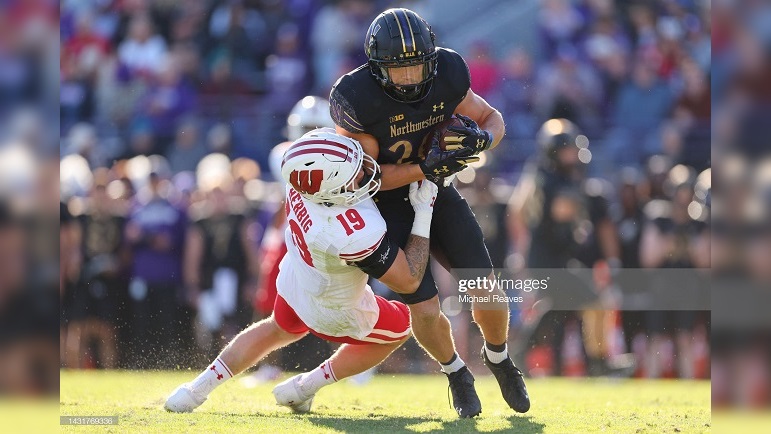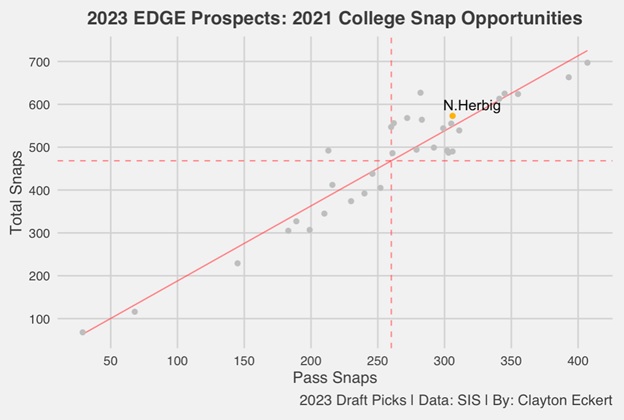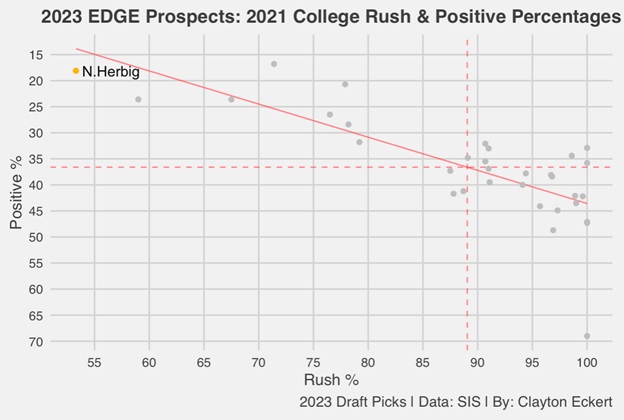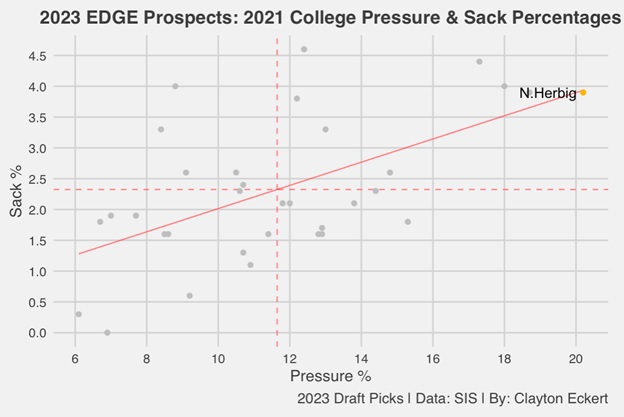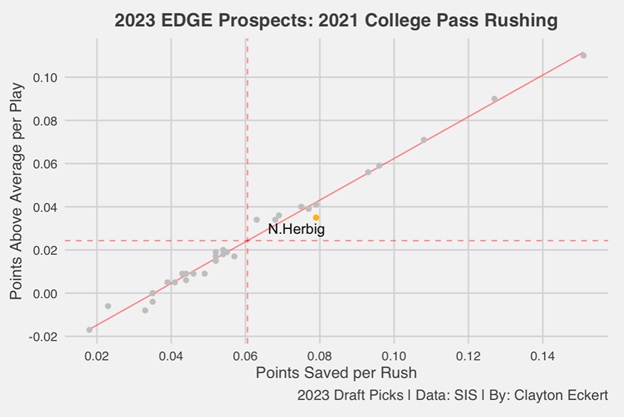Continuing the series, I wanted to circle back to the edge rusher position, where Pittsburgh selected Nick Herbig at pick 132 in the fourth round. In the pre-draft process, there was much conversation on Herbig being projected to move to the inside linebacker position in the NFL, but general manager Omar Khan is leaving the door open for him to play both, at least initially. With all this in mind — and considering Herbig played the vast majority of his snaps on the edge for Wisconsin — this article will look at the position in 2021 using Sports Info Solutions (SIS), following my 2022 pass rush and run defense studies.
Today I’ll focus on players who heard their names called in the draft, also including other players who were debatable edge/linebacker “tweeners”, and two players were excluded due to SIS not tracking smaller schools. The goal is to see how Herbig stacked up among his peers.
First, let’s look at pass snaps along with their total snaps to get a gauge of the players’ opportunities, and how often they were on the field last season:
In 2021, Herbig was above the mean in both data points, with 573 total snaps (seventh) and 306 pass snaps, which tied for seventh of the 33 qualifying players, providing great availability and playing in every game. In comparison to last season, he had 503 total snaps (21st) and 268 pass snaps (22nd), missing just one game due to a knee injury. Important quantity context as we dive deeper into his quality of play and compare his final two college seasons.
Next, let’s look at the percentages that the players rushed the passer on pass plays, along with Sports Info Solutions positive play %, defined as the rate of pass plays with the player on the field that resulted in a positive expected points added (EPA), with lower percentages being the best:
Herbig lands on a similar point on the graph compared to 2022, having the lowest rush percentage of the qualifying players in each of the last two seasons. In 2021, that number came in at 53.3%, compared to 60.1% last season. So, Wisconsin asked him to rush the passer more last year when he put up stellar production, including his top ranked 24.4% positive percentage. In 2021, he also fared very well with an even stronger figure of 18.8% that ranked second. Encouraging comparative context to his peers, highlighting Herbig as an important and successful cog to the Badgers pass rush each season, though he was not a one-trick pony being asked to do more than just rushing the passer as many others at the position did primarily.
Speaking of pass rushing impact, let’s look at essential numbers for the topic, pressure and sack percentages:
Once again, Herbig was comfortably above the mean in quality aspects of his play, with a top ranked 20.2% pressure rate, which was the only 20+ percentage. He also accomplished this feat last season, the only 2023 draft pick at the position to do so. This adds even more optimism moving forward with two productive pass rushing seasons against quality competition, though it is important to factor in his lowest rush opportunities. Herbig’s 3.9% sack rate was also strong (T-fifth), with nine sacks in 2021.
He encouragingly improved this rate to 6.7% last season, which was comfortably the best of the position, but as I pointed out last article, four of his 11 sacks were deemed unblocked by SIS and of less quality though impressively on less snaps. This is a big difference compared to 2021, when none of his nine sacks were deemed unblocked, which is an impressive element of those sacks. Very solid production overall the last two years, justifying Pittsburgh playing him at edge first, in my opinion, despite the size concerns from many evaluators.
To close, here is a more total view of the players as pass rushers using points saved per rush (The total of a player’s EPA responsibility on pass plays using the Total Points system that distributes credit among all players on the field for a given play (with positive numbers being good). Totals are scaled up to map to the average points scored or allowed on a team level, with the player’s snap count determining how much to adjust.
For pass rushers, this includes accounting for sacks, blown blocks forced, turnovers, turnover returns, and other disruptions at the line of scrimmage. Values are modulated using a quality-of-competition multiplier based on each opponent’s previous year of performance and points above average per play (using the same Total Points system and putting a number to their value above an average level player):
In totality, Herbig lands above the mean in both data points, but a bit lower in the ranks. His points saved per rush tied for sixth, along with a 10th rank in points above average per play. This points to less of overall impact on a play-by-play basis in 2021, compared to last season when he ranked first and second, respectively. He also tallied a forced fumble, pass deflection, and drew a holding penalty, upping his production in these terms as well last season with two forced fumbles, three pass deflections, and a holding penalty drawn.
Very encouraged by the data context, with nice production each season, including the desired positive trajectory in his final campaign in 2022.
So, in 2021, Herbig had the top ranked pressure percentage, which he also provided last season. He was also top 10 in positive percentage (second), sack rate (T-fifth), points saved per rush (sixth), total snaps (seventh), pass snaps (T-seventh), and points above average per play (tenth). His only below the mean result was the lowest rush rate at the position, which was also the case in 2022 and a very important element to factor in.
Last season, Herbig encouragingly improved across the board in many regards including top ranks in positive, pressure, and sack rate along with points saved per rush, while also ranking second in points above average per play. His only average results came in snap opportunities and had the lowest rush percentage, which did increase from 2021 and points to the various aspects of the game that he provided for Wisconsin.
While size is a definite concern as Herbig begins his NFL journey, factoring in this production across two seasons against the quality level of competition is important to consider on the optimistic side. What better position room to be in with than with fellow former Badger T.J. Watt, to hopefully continue to maximize his skills (Herbig has worked with and picked Watt’s brain in the past). I’m also excited to potentially see him on the field with fellow Steelers draft pick from Wisconsin Keeanu Benton, who also adds pass rush juice on the interior defensive line. The Badger connection is definitely strong in Pittsburgh, and here’s to hoping their additions help the 2023 Steelers pass rush return to more dominance than last season.
If it doesn’t pan out at edge rusher for Herbig, I agree with several others on our Steelers Depot team that have pointed out his pass rushing skills being intriguing at the off-ball linebacker spot, perhaps a more translatable expectation in the long term.
Throughout the rest of the offseason, I will dive deeper into the data as we continue to learn about the newest Pittsburgh Steelers.

